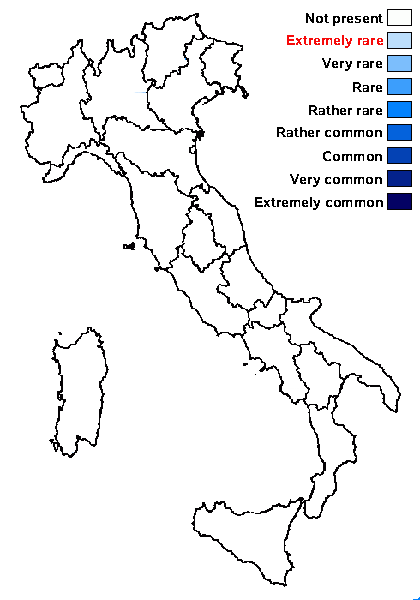Synarthonia leproidica Ertz, Aptroot & Diederich
in Ertz & al., Lichenologist, 52: 263, 2020.
Synonyms:
Distribution:
Description: Thallus leprose, up to 1(-2) mm thick, pale grey with a dark brown/violaceous tinge, greenish inside when abraded, forming 0.5-5 mm wide patches which are often confluent into up to 10 cm wide areas, sorediate. Soredia (14-)20-38 μm in diam., formed of photobiont cells surrounded by hyaline to dark brown, 2(-3) μm thick hyphae which are not projecting, encrusted with many colourless, 0.5-1.5 μm wide crystals dissolving in K, visible under polarized light. Apothecia and pycnidia not known. Photobiont trentepohlioid, the cells globose and (6-)9-15(-25) μm wide, or arranged in short chains of c. 2-4, elliptical to rectangular cells measuring 13-20(-29) x (5-)9-16 μm. Spot tests: K-, C-, KC-, P+ bright orange-yellow, UV-; the hyphae I+ pale orange. Chemistry: psoromic acid. Note: a recently-described species of sheltered siliceous rocks, hitherto known only from a few localities in Luxembourg. It could have an Atlantic distribution in Europe, but due to the fact that it may be easily overlooked, being always sterile, its presence in Italy cannot be excluded. For further details see Ertz & al. (2020). To be looked for in Tyrrhenian Italy.
Growth form: Leprose
Substrata: rocks
Photobiont: Trentepohlia
Reproductive strategy: mainly asexual, by soredia, or soredia-like structures (e.g. blastidia)
Most common in areas with a humid-warm climate (e.g. most of Tyrrenian Italy)

Predictive model
Growth form: Leprose
Substrata: rocks
Photobiont: Trentepohlia
Reproductive strategy: mainly asexual, by soredia, or soredia-like structures (e.g. blastidia)
Most common in areas with a humid-warm climate (e.g. most of Tyrrenian Italy)

Predictive model

